Weili Nie
Rethinking Molecule Synthesizability with Chain-of-Reaction
Sep 19, 2025Abstract:A well-known pitfall of molecular generative models is that they are not guaranteed to generate synthesizable molecules. There have been considerable attempts to address this problem, but given the exponentially large combinatorial space of synthesizable molecules, existing methods have shown limited coverage of the space and poor molecular optimization performance. To tackle these problems, we introduce ReaSyn, a generative framework for synthesizable projection where the model explores the neighborhood of given molecules in the synthesizable space by generating pathways that result in synthesizable analogs. To fully utilize the chemical knowledge contained in the synthetic pathways, we propose a novel perspective that views synthetic pathways akin to reasoning paths in large language models (LLMs). Specifically, inspired by chain-of-thought (CoT) reasoning in LLMs, we introduce the chain-of-reaction (CoR) notation that explicitly states reactants, reaction types, and intermediate products for each step in a pathway. With the CoR notation, ReaSyn can get dense supervision in every reaction step to explicitly learn chemical reaction rules during supervised training and perform step-by-step reasoning. In addition, to further enhance the reasoning capability of ReaSyn, we propose reinforcement learning (RL)-based finetuning and goal-directed test-time compute scaling tailored for synthesizable projection. ReaSyn achieves the highest reconstruction rate and pathway diversity in synthesizable molecule reconstruction and the highest optimization performance in synthesizable goal-directed molecular optimization, and significantly outperforms previous synthesizable projection methods in synthesizable hit expansion. These results highlight ReaSyn's superior ability to navigate combinatorially-large synthesizable chemical space.
One-step Diffusion Models with $f$-Divergence Distribution Matching
Feb 21, 2025Abstract:Sampling from diffusion models involves a slow iterative process that hinders their practical deployment, especially for interactive applications. To accelerate generation speed, recent approaches distill a multi-step diffusion model into a single-step student generator via variational score distillation, which matches the distribution of samples generated by the student to the teacher's distribution. However, these approaches use the reverse Kullback-Leibler (KL) divergence for distribution matching which is known to be mode seeking. In this paper, we generalize the distribution matching approach using a novel $f$-divergence minimization framework, termed $f$-distill, that covers different divergences with different trade-offs in terms of mode coverage and training variance. We derive the gradient of the $f$-divergence between the teacher and student distributions and show that it is expressed as the product of their score differences and a weighting function determined by their density ratio. This weighting function naturally emphasizes samples with higher density in the teacher distribution, when using a less mode-seeking divergence. We observe that the popular variational score distillation approach using the reverse-KL divergence is a special case within our framework. Empirically, we demonstrate that alternative $f$-divergences, such as forward-KL and Jensen-Shannon divergences, outperform the current best variational score distillation methods across image generation tasks. In particular, when using Jensen-Shannon divergence, $f$-distill achieves current state-of-the-art one-step generation performance on ImageNet64 and zero-shot text-to-image generation on MS-COCO. Project page: https://research.nvidia.com/labs/genair/f-distill
A2SB: Audio-to-Audio Schrodinger Bridges
Jan 20, 2025Abstract:Audio in the real world may be perturbed due to numerous factors, causing the audio quality to be degraded. The following work presents an audio restoration model tailored for high-res music at 44.1kHz. Our model, Audio-to-Audio Schrodinger Bridges (A2SB), is capable of both bandwidth extension (predicting high-frequency components) and inpainting (re-generating missing segments). Critically, A2SB is end-to-end without need of a vocoder to predict waveform outputs, able to restore hour-long audio inputs, and trained on permissively licensed music data. A2SB is capable of achieving state-of-the-art bandwidth extension and inpainting quality on several out-of-distribution music test sets. Our demo website is https: //research.nvidia.com/labs/adlr/A2SB/.
BlobGEN-Vid: Compositional Text-to-Video Generation with Blob Video Representations
Jan 13, 2025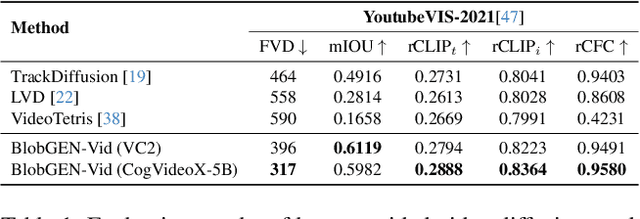
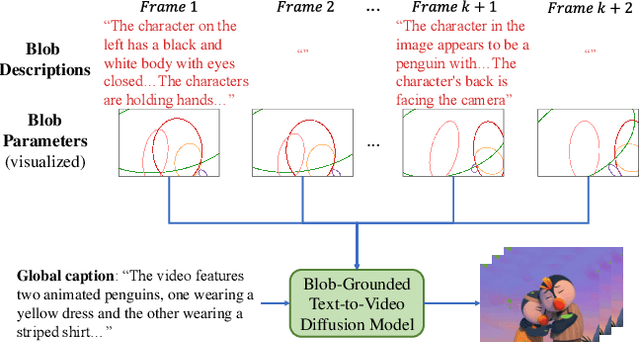


Abstract:Existing video generation models struggle to follow complex text prompts and synthesize multiple objects, raising the need for additional grounding input for improved controllability. In this work, we propose to decompose videos into visual primitives - blob video representation, a general representation for controllable video generation. Based on blob conditions, we develop a blob-grounded video diffusion model named BlobGEN-Vid that allows users to control object motions and fine-grained object appearance. In particular, we introduce a masked 3D attention module that effectively improves regional consistency across frames. In addition, we introduce a learnable module to interpolate text embeddings so that users can control semantics in specific frames and obtain smooth object transitions. We show that our framework is model-agnostic and build BlobGEN-Vid based on both U-Net and DiT-based video diffusion models. Extensive experimental results show that BlobGEN-Vid achieves superior zero-shot video generation ability and state-of-the-art layout controllability on multiple benchmarks. When combined with an LLM for layout planning, our framework even outperforms proprietary text-to-video generators in terms of compositional accuracy.
GenMol: A Drug Discovery Generalist with Discrete Diffusion
Jan 10, 2025



Abstract:Drug discovery is a complex process that involves multiple scenarios and stages, such as fragment-constrained molecule generation, hit generation and lead optimization. However, existing molecular generative models can only tackle one or two of these scenarios and lack the flexibility to address various aspects of the drug discovery pipeline. In this paper, we present Generalist Molecular generative model (GenMol), a versatile framework that addresses these limitations by applying discrete diffusion to the Sequential Attachment-based Fragment Embedding (SAFE) molecular representation. GenMol generates SAFE sequences through non-autoregressive bidirectional parallel decoding, thereby allowing utilization of a molecular context that does not rely on the specific token ordering and enhanced computational efficiency. Moreover, under the discrete diffusion framework, we introduce fragment remasking, a strategy that optimizes molecules by replacing fragments with masked tokens and regenerating them, enabling effective exploration of chemical space. GenMol significantly outperforms the previous GPT-based model trained on SAFE representations in de novo generation and fragment-constrained generation, and achieves state-of-the-art performance in goal-directed hit generation and lead optimization. These experimental results demonstrate that GenMol can tackle a wide range of drug discovery tasks, providing a unified and versatile approach for molecular design.
Molecule Generation with Fragment Retrieval Augmentation
Nov 18, 2024



Abstract:Fragment-based drug discovery, in which molecular fragments are assembled into new molecules with desirable biochemical properties, has achieved great success. However, many fragment-based molecule generation methods show limited exploration beyond the existing fragments in the database as they only reassemble or slightly modify the given ones. To tackle this problem, we propose a new fragment-based molecule generation framework with retrieval augmentation, namely Fragment Retrieval-Augmented Generation (f-RAG). f-RAG is based on a pre-trained molecular generative model that proposes additional fragments from input fragments to complete and generate a new molecule. Given a fragment vocabulary, f-RAG retrieves two types of fragments: (1) hard fragments, which serve as building blocks that will be explicitly included in the newly generated molecule, and (2) soft fragments, which serve as reference to guide the generation of new fragments through a trainable fragment injection module. To extrapolate beyond the existing fragments, f-RAG updates the fragment vocabulary with generated fragments via an iterative refinement process which is further enhanced with post-hoc genetic fragment modification. f-RAG can achieve an improved exploration-exploitation trade-off by maintaining a pool of fragments and expanding it with novel and high-quality fragments through a strong generative prior.
Multi-student Diffusion Distillation for Better One-step Generators
Oct 30, 2024

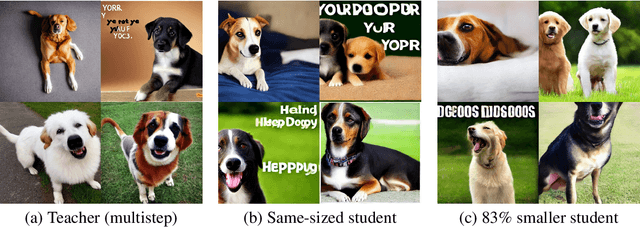
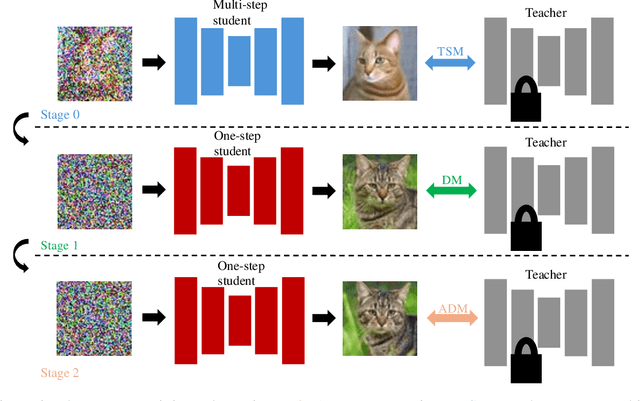
Abstract:Diffusion models achieve high-quality sample generation at the cost of a lengthy multistep inference procedure. To overcome this, diffusion distillation techniques produce student generators capable of matching or surpassing the teacher in a single step. However, the student model's inference speed is limited by the size of the teacher architecture, preventing real-time generation for computationally heavy applications. In this work, we introduce Multi-Student Distillation (MSD), a framework to distill a conditional teacher diffusion model into multiple single-step generators. Each student generator is responsible for a subset of the conditioning data, thereby obtaining higher generation quality for the same capacity. MSD trains multiple distilled students, allowing smaller sizes and, therefore, faster inference. Also, MSD offers a lightweight quality boost over single-student distillation with the same architecture. We demonstrate MSD is effective by training multiple same-sized or smaller students on single-step distillation using distribution matching and adversarial distillation techniques. With smaller students, MSD gets competitive results with faster inference for single-step generation. Using 4 same-sized students, MSD sets a new state-of-the-art for one-step image generation: FID 1.20 on ImageNet-64x64 and 8.20 on zero-shot COCO2014.
Energy-Based Diffusion Language Models for Text Generation
Oct 28, 2024


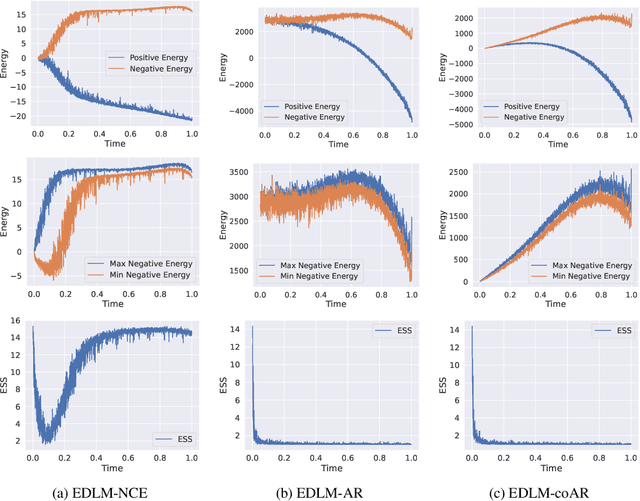
Abstract:Despite remarkable progress in autoregressive language models, alternative generative paradigms beyond left-to-right generation are still being actively explored. Discrete diffusion models, with the capacity for parallel generation, have recently emerged as a promising alternative. Unfortunately, these models still underperform the autoregressive counterparts, with the performance gap increasing when reducing the number of sampling steps. Our analysis reveals that this degradation is a consequence of an imperfect approximation used by diffusion models. In this work, we propose Energy-based Diffusion Language Model (EDLM), an energy-based model operating at the full sequence level for each diffusion step, introduced to improve the underlying approximation used by diffusion models. More specifically, we introduce an EBM in a residual form, and show that its parameters can be obtained by leveraging a pretrained autoregressive model or by finetuning a bidirectional transformer via noise contrastive estimation. We also propose an efficient generation algorithm via parallel important sampling. Comprehensive experiments on language modeling benchmarks show that our model can consistently outperform state-of-the-art diffusion models by a significant margin, and approaches autoregressive models' perplexity. We further show that, without any generation performance drop, our framework offers a 1.3$\times$ sampling speedup over existing diffusion models.
Warped Diffusion: Solving Video Inverse Problems with Image Diffusion Models
Oct 21, 2024



Abstract:Using image models naively for solving inverse video problems often suffers from flickering, texture-sticking, and temporal inconsistency in generated videos. To tackle these problems, in this paper, we view frames as continuous functions in the 2D space, and videos as a sequence of continuous warping transformations between different frames. This perspective allows us to train function space diffusion models only on images and utilize them to solve temporally correlated inverse problems. The function space diffusion models need to be equivariant with respect to the underlying spatial transformations. To ensure temporal consistency, we introduce a simple post-hoc test-time guidance towards (self)-equivariant solutions. Our method allows us to deploy state-of-the-art latent diffusion models such as Stable Diffusion XL to solve video inverse problems. We demonstrate the effectiveness of our method for video inpainting and $8\times$ video super-resolution, outperforming existing techniques based on noise transformations. We provide generated video results: https://giannisdaras.github.io/warped\_diffusion.github.io/.
Truncated Consistency Models
Oct 18, 2024



Abstract:Consistency models have recently been introduced to accelerate sampling from diffusion models by directly predicting the solution (i.e., data) of the probability flow ODE (PF ODE) from initial noise. However, the training of consistency models requires learning to map all intermediate points along PF ODE trajectories to their corresponding endpoints. This task is much more challenging than the ultimate objective of one-step generation, which only concerns the PF ODE's noise-to-data mapping. We empirically find that this training paradigm limits the one-step generation performance of consistency models. To address this issue, we generalize consistency training to the truncated time range, which allows the model to ignore denoising tasks at earlier time steps and focus its capacity on generation. We propose a new parameterization of the consistency function and a two-stage training procedure that prevents the truncated-time training from collapsing to a trivial solution. Experiments on CIFAR-10 and ImageNet $64\times64$ datasets show that our method achieves better one-step and two-step FIDs than the state-of-the-art consistency models such as iCT-deep, using more than 2$\times$ smaller networks. Project page: https://truncated-cm.github.io/
 Add to Chrome
Add to Chrome Add to Firefox
Add to Firefox Add to Edge
Add to Edge